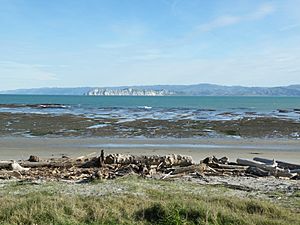Young Nick's Head facts for kids
Quick facts for kids Young Nick's Head |
|
|---|---|
| Te Kuri o Pāoa | |

Young Nick's Head from Kaiti Beach
|
|
| Location | Poverty Bay, New Zealand |
| Coordinates | 38°45′25″S 177°57′49″E / 38.7570°S 177.9636°E |
Young Nick's Head is a special piece of land found at the southern end of Poverty Bay in New Zealand's North Island. It is a headland, which means it is a high point of land that sticks out into the sea.
This area is very important in Māori history. Around the year 1350 AD, the waka (large canoes) named Horouta and Te Ikaroa-a-Rauru landed here. These canoes brought the first Māori settlers to this region. In the Māori language, this headland is called Te Kuri o Pāoa. This name means "The Dog of Pāoa".
The small town of Muriwai is located just a short distance inland from Young Nick's Head.
Contents
What's in a Name?
Young Nick's Head has a cool story behind its name. Many people think it was the first land seen by the crew of Captain James Cook's ship, the Endeavour. This happened on Friday, October 6, 1769.
Captain Cook had promised a reward to the first person on his ship to spot land. This reward went to a 12-year-old boy named Nicholas Young. He was an assistant to the ship's doctor. His prize was two gallons of rum, and a famous landmark was named after him!
The Māori Name: Te Kuri o Pāoa
Before Captain Cook arrived, Māori people already knew this headland as Te Kuri o Pāoa. This name means "The Dog of Pāoa".
Māori legends tell a story about Pāoa, who lost his dog (a type of Māori dog) in the Poverty Bay area. The legend says that the dog is still there, waiting for its master to come back. People say that at sunrise, the white cliffs of the headland look like the shape of a dog crouching down.
Nick's Head Station: A Special Place
Nick's Head Station is a large area that includes the headland itself, along with its nearby coast, wetlands, and farmland. This property covers about 661 hectares.
Today, it is owned by John Griffin, a financier from New York. After he bought the property in 2002, Mr. Griffin started a big, long-term project. His goal was to bring back the natural plants and animals to the area.
Bringing Nature Back
- Over 600,000 trees have been planted across the station.
- About 26 hectares of wetlands have been restored. Wetlands are important areas where water covers the land, helping many plants and animals.
- A special 2-meter-high fence was built to keep out animals that might harm native species.
- Native animals like Tuatara, Blue Penguins, and Wētā have been brought back to live there.
In 2005, a company called Ecoworks helped bring back six types of pelagic (ocean-living) seabirds to Young Nick's Head. These birds had been badly affected by people settling in the area and by new predators. Ecoworks used solar-powered sounds and fake burrows to help the birds start breeding colonies again.
Protecting the Land: A Protest in 2002
Nick's Head Station was put up for sale in November 2000. In January 2002, John Griffin agreed to buy the property for $4 million. Before this, a Māori iwi (tribe) called Ngai Tamanuhiri tried to buy it, but they couldn't get enough money.
Some local Māori people were upset about the land being sold to someone from another country. They felt this land was very important to their culture and history. A group led by Tu Wyllie protested by staying on Young Nick's Head and holding protests at Parliament.
After discussions with the iwi, the Finance Minister at the time, Michael Cullen, made an announcement in August 2002. He said that "Young Nick’s Head will be protected." He also said that the cliffs, an old pā (fortified village) site, and the peak of Te Kuri would be given to public ownership. This was part of the deal for buying Nick's Head Station.
Mr. Griffin also agreed to protect the rest of the headland from building projects. He did this by setting up an agreement through the Queen Elizabeth II National Trust. This helps make sure the land stays natural and open for everyone to enjoy.

